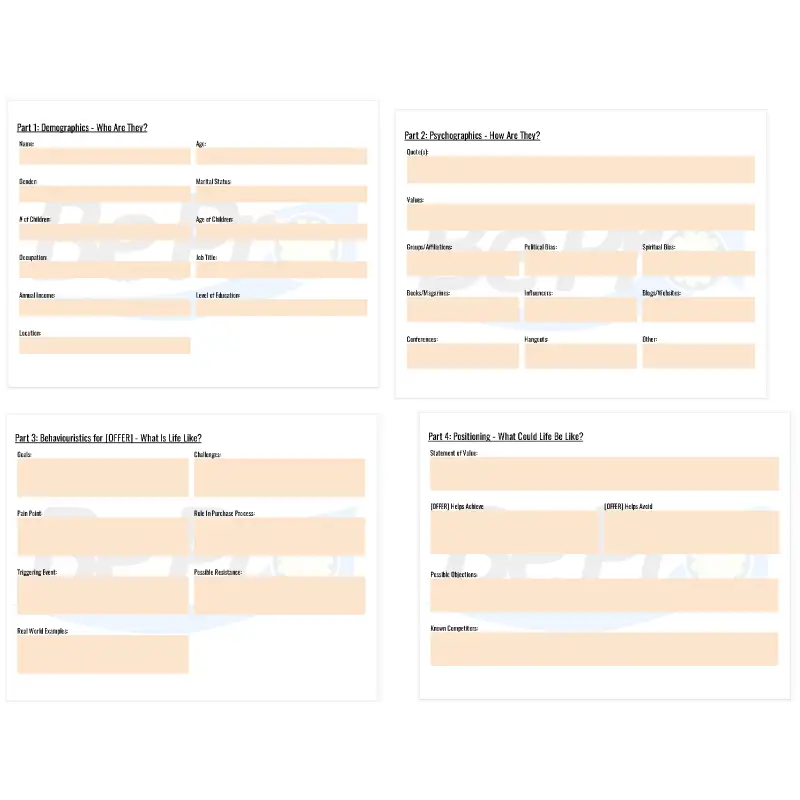We’ve seen this question a LOT and in different ways. The hard part about answering this is there is no one solution to it. Looking for the people who need a real estate agent? Well, you’re going to have to try a different strategy than the consultant over there, who is looking for people that require their professional services. When you have a well-defined customer profile, you can make better decisions about where to find buyers.
Before you go all willy-nilly with your ad spend, take some time to get clear on what matters to the people you want to attract. Rather than focusing on the question of “who are they?”, find out more about how they behave. Answer questions like:
- Where do they get their news from?
- What kinds of books & podcasts do they consume?
- Who are the celebrities they follow?
- What kinds of things are they outspoken about?
The purpose here is to get into your audience’s world. The questions above are meant to look past the external profile people tend to display and get to the root of their behavior. Understanding how your audience views life and applying it to your ads will make your content resonate more deeply with potential customers. This is where a customer profile will give you an advantage.
We created the Be Pro Customer Profile Template with the intent to help you get deeper insights into your audience. It is broken down into four parts: Demographics, Psychographics, Behaviouristic, and Positioning.

The Demographic and Psychographic sections cover the most common features marketers look for. (Age, Gender, Family Status, Education, Income, Affiliations) Included in this data is Information Sources, which help us collect details about who and/or what gets your audiences’ attention. We like to gather the information for these sections by combing through customers’ social profiles. Ideally, you’ll already have a handful of real customers’ profiles to comb through. If not, you will have to settle for digging through random profiles of the members of your audience to find what they have in common. It sounds a bit creepy, but we promise you’ll find a wealth of information.
Once you have enough data to fill in the first two parts, you’ll have to use some creative guesswork for Part 3. In the Behaviouristics section, we start to look at what life is like for this demographic of the audience. Think about their goals and the challenges they face. What are their pain points? And what triggers them into needing to buy what you’re offering? We find it helps to think of real-world examples of people who personify these traits.
When you can answer the deeper questions about who your audience is, you can start to work on the final part of the customer profile: Positioning.
This is the fun stuff that most marketers jump right to. But we’ve all heard the old analogy of how marketing is like dating. You can’t just run into a bar and start asking people to marry you. That’s just weird. So instead, we’ve gone through the work to tell you exactly what you need to know about your audience so you can know how to talk to them. And again, we go deeper than just whether they prefer blogs or videos.
The Positioning section of the Be Pro Customer Profile Template transform the Behaviouristic data into the language your audience uses. This includes what your offer will help them achieve or avoid, possible objections, known competitors, and a before/after of different states your audience will be in. Lastly, included in our Customer Profile Template is the Elevator Pitch, which serves as a short, simple explanation of who you are and what you have to offer.
Now that you have all this knowledge, what are you to do with it?
Here are a few examples:
- Create Organic Content: Put those creative juices to work! Look at the data that you collected and see what shows up. What topics are going to engage your audience? And what content are they most likely to engage with? If you have an audience that is all about YouTube but you’ve been putting your effort into LinkedIn, it may be time to switch up your channel AND content strategy. Not everything is going to be that extreme and be prepared to make some pivots.
- Run Paid Ads: This is the obvious answer. We also see it as being so important that we have to mention it anyway. Integrate your customer profile data with your paid marketing efforts. If you don’t, you’re wasting your marketing budget. The data you extract with a customer profile will help get the most qualified audience into your funnels without having to gamble with your money.
- Validate Your Profile: Just because your profile sheet is completely filled in, don’t think you’re done with it. The customer profile still needs to be validated against actual data. This will require setting up tests across both organic and paid efforts to see the response to changes in content and targeting.
As you can see, finding your ideal target is an ongoing quest. If you want to get a head start on defining your customer profile, go ahead and download our customer profile template and learn how to make this work for you and your business.

That was not common. Wow. Ever since I read Dan Kennedys book No BS Social media marketing. I saw immediate drastic change. Unbelievable.
Glad you enjoyed it 🤗